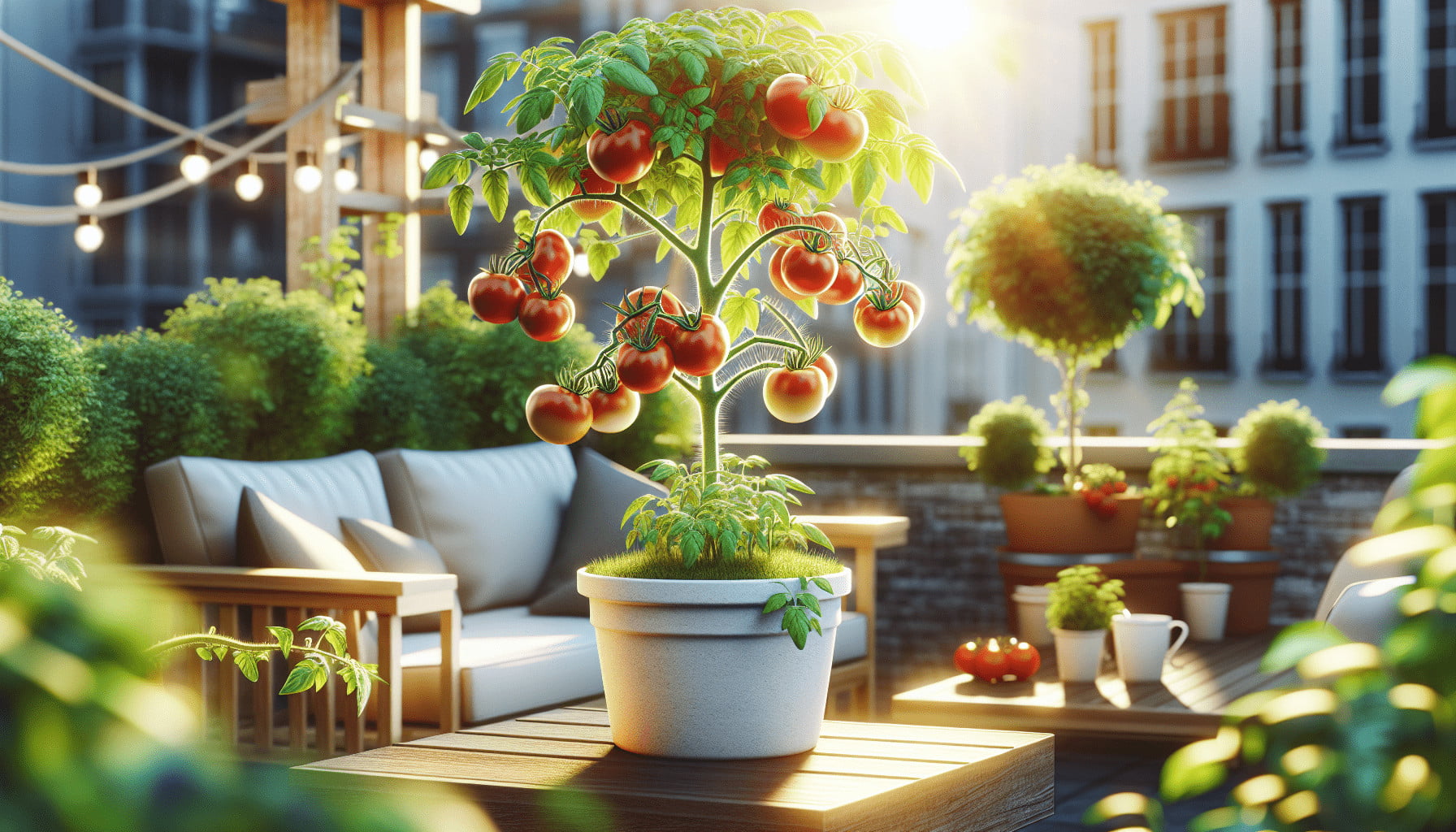Welcome to the wonderful world of gardening on your rooftop! In this article, you will learn all the tips and tricks on how to successfully grow tomatoes on your rooftop garden. From choosing the right containers to selecting the best tomato varieties, we’ve got you covered. Get ready to enjoy delicious, homegrown tomatoes right from your own rooftop oasis! Have you ever dreamed of having your own rooftop garden filled with fresh, juicy tomatoes? Imagine stepping outside and plucking a perfectly ripe tomato to add to your salad or sandwich. Well, with a little time and effort, you can make that dream a reality. In this article, we will guide you through the process of growing tomatoes on your rooftop garden. From choosing the right varieties to providing the optimal growing conditions, we’ve got you covered. So, grab your gardening gloves and let’s get started!

Choosing the Right Tomato Varieties
When it comes to growing tomatoes on your rooftop garden, choosing the right varieties is crucial. With so many options available, it can be overwhelming to decide which ones to plant. Here are some popular varieties that are well-suited for rooftop gardens:
Cherry Tomatoes
Cherry tomatoes are small, round, and incredibly sweet. They are perfect for snacking, salads, and even roasting. Some popular cherry tomato varieties include Sweet 100, Sun Gold, and Black Cherry.
Roma Tomatoes
Roma tomatoes are a popular choice for sauces, salsas, and canning. They have a dense flesh and low seed content, making them ideal for cooking. Some popular Roma tomato varieties include San Marzano, Amish Paste, and Viva Italia.
Beefsteak Tomatoes
Beefsteak tomatoes are large, meaty, and perfect for slicing on sandwiches or burgers. They come in a variety of colors, including red, yellow, and orange. Some popular beefsteak tomato varieties include Brandywine, Mortgage Lifter, and Cherokee Purple.
Choosing a mix of tomato varieties will give you a variety of flavors, colors, and sizes to enjoy throughout the growing season. Experiment with different varieties to find your favorites!
Preparing Your Rooftop Garden
Before you start planting your tomato seeds or seedlings, you’ll need to prepare your rooftop garden. Here are some steps to ensure your garden is ready for tomato plants:
Assess Sunlight Exposure
Tomatoes need at least 6-8 hours of sunlight per day to thrive. Check the sun exposure on your rooftop throughout the day to determine the best spots for planting your tomatoes. Avoid areas that are shaded by buildings or trees.
Prepare Containers or Raised Beds
Since rooftop gardens often have limited space, you’ll need to plant your tomatoes in containers or raised beds. Make sure the containers have drainage holes to prevent waterlogging. Use high-quality potting soil to provide nutrients for your plants.
Install Support Structures
Tomato plants need support to grow vertically and prevent them from falling over. Install trellises, cages, or stakes in your containers or raised beds to support your tomato plants as they grow. This will also help improve air circulation around the plants.
By taking these steps to prepare your rooftop garden, you’ll create a suitable environment for growing healthy and productive tomato plants.
Planting Tomato Seeds or Seedlings
Once your rooftop garden is prepared, it’s time to plant your tomato seeds or seedlings. Here’s how to get started:
Starting from Seeds
If you’re starting from seeds, sow them indoors 6-8 weeks before the last frost date in your area. Plant the seeds in small containers filled with potting soil, water them gently, and keep them in a warm, sunny location. Once the seedlings have 2-3 sets of true leaves, they are ready to be transplanted outdoors.
Transplanting Seedlings
If you’re starting with seedlings, gently remove them from their containers and transplant them into your rooftop garden. Dig a hole slightly larger than the root ball of the seedling and place it in the soil. Firmly pat down the soil around the seedling to secure it in place.
Spacing and Depth
When planting tomato seedlings, space them at least 18-24 inches apart to allow room for growth. Dig a hole deep enough to cover the root ball and the lower set of leaves. This will encourage the development of a strong root system and stem.
By following these steps, you’ll ensure that your tomato plants get off to a healthy start and have the best chance of thriving in your rooftop garden.
Caring for Your Tomato Plants
Once your tomato plants are in the ground, it’s important to provide them with the care they need to grow and produce delicious tomatoes. Here are some tips for caring for your tomato plants:
Watering
Tomato plants need consistent moisture to prevent them from drying out or becoming waterlogged. Water your plants deeply and evenly once a week, or more frequently during hot, dry weather. Avoid getting the leaves wet to prevent foliar diseases.
Fertilizing
Tomato plants are heavy feeders and require regular fertilization to thrive. Start by mixing a balanced fertilizer into the soil at planting time. As the plants grow, supplement with a liquid fertilizer every 2-3 weeks to provide additional nutrients.
Pruning
To encourage healthy growth and better fruit production, prune your tomato plants regularly. Remove suckers (small side shoots) that grow between the main stem and branches. This will help improve air circulation and light penetration, leading to larger and tastier tomatoes.
Mulching
Mulching around your tomato plants can help retain moisture in the soil, prevent weeds from growing, and regulate soil temperature. Use organic mulch, such as straw, wood chips, or grass clippings, to cover the soil evenly around the plants.
By following these care tips, you’ll help your tomato plants stay healthy and productive throughout the growing season.

Dealing with Common Tomato Plant Pests and Diseases
Despite your best efforts, your tomato plants may still encounter pests and diseases that can damage or kill them. Here are some common issues to watch out for and how to deal with them:
Aphids
Aphids are small, soft-bodied insects that feed on the sap of tomato plants, causing yellowing leaves and stunted growth. To control aphids, spray your plants with a strong stream of water to dislodge them, or apply insecticidal soap as a natural remedy.
Tomato Hornworms
Tomato hornworms are large, green caterpillars that can devour entire tomato plants overnight. Handpick the caterpillars from your plants and dispose of them in a bucket of soapy water. You can also attract natural predators, such as parasitic wasps, to control hornworm populations.
Early Blight
Early blight is a common fungal disease that affects tomato plants, causing dark spots on the leaves, stems, and fruit. To prevent early blight, avoid overhead watering, space your plants properly for good air circulation, and apply a copper fungicide as a preventive measure.
Blossom End Rot
Blossom end rot is a physiological disorder caused by calcium deficiency in tomato plants, resulting in dark, sunken spots on the bottom of the fruit. To prevent blossom end rot, maintain consistent moisture levels, provide adequate calcium through fertilization, and avoid fluctuations in soil pH.
By recognizing and addressing these common tomato plant pests and diseases early on, you can protect your plants and ensure a successful harvest of tomatoes.
Harvesting and Enjoying Your Homegrown Tomatoes
After weeks of nurturing your tomato plants, the moment you’ve been waiting for has arrived – it’s time to harvest your homegrown tomatoes. Here are some tips for harvesting and enjoying your ripe, juicy tomatoes:
Harvesting
Pick your tomatoes when they are fully ripe and have reached their desired color and size. Gently twist or cut the tomatoes from the vine using a pair of scissors or pruners to avoid damaging the plant. Store ripe tomatoes at room temperature to maintain their flavor and texture.
Enjoying
There are countless ways to enjoy your homegrown tomatoes, from simple salads and sandwiches to flavorful sauces and salsas. Experiment with different recipes and cooking methods to showcase the freshness and flavor of your tomatoes. Share your bountiful harvest with friends and family to spread the joy of rooftop gardening.
Saving Seeds
If you’ve grown heirloom or open-pollinated tomato varieties, consider saving seeds from your best-performing plants for future seasons. Allow the tomato fruit to fully ripen on the vine, remove the seeds, rinse off the pulp, and dry them thoroughly before storing them in a cool, dry place.
By savoring the fruits of your labor and sharing your homegrown tomatoes with others, you’ll appreciate the rewards of rooftop gardening and the satisfaction of growing your own food.
In conclusion, growing tomatoes on your rooftop garden is a rewarding experience that allows you to enjoy the fresh flavors of homegrown tomatoes right at your fingertips. By choosing the right varieties, preparing your rooftop garden, planting tomato seeds or seedlings, caring for your tomato plants, dealing with common pests and diseases, and harvesting and enjoying your homegrown tomatoes, you’ll be well on your way to a successful tomato-growing season. So, roll up your sleeves, get your hands dirty, and watch your rooftop garden flourish with ripe, juicy tomatoes!
